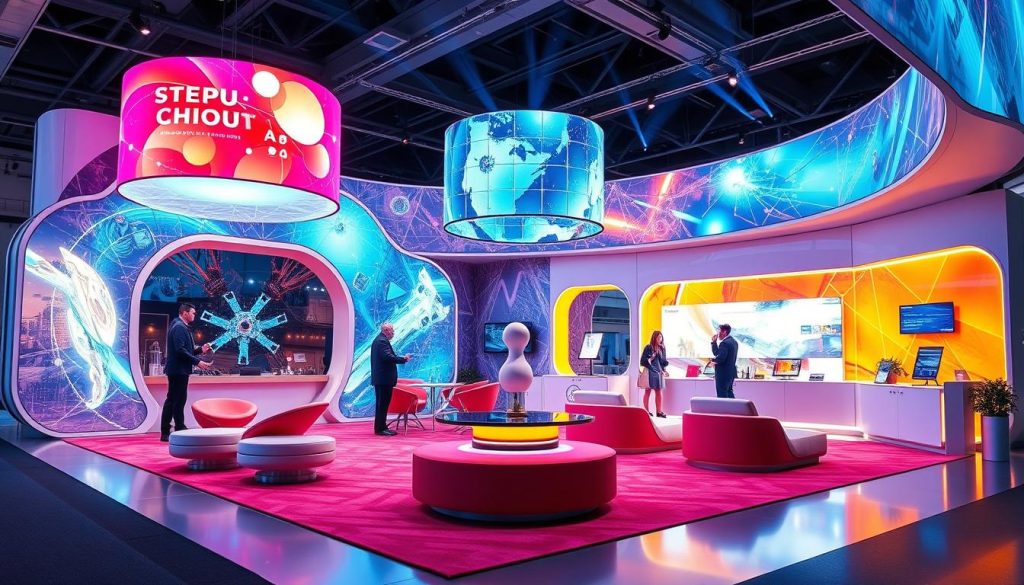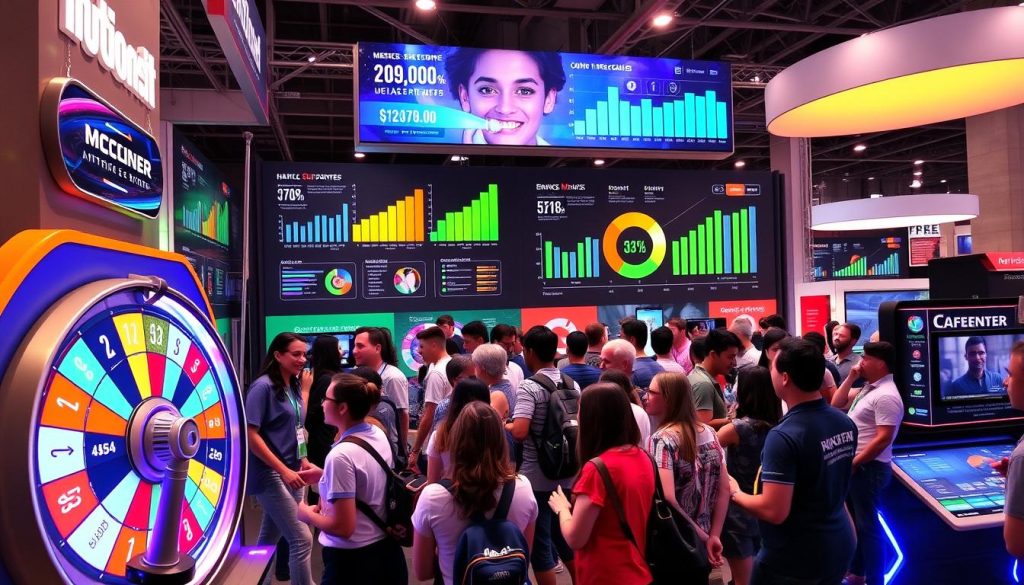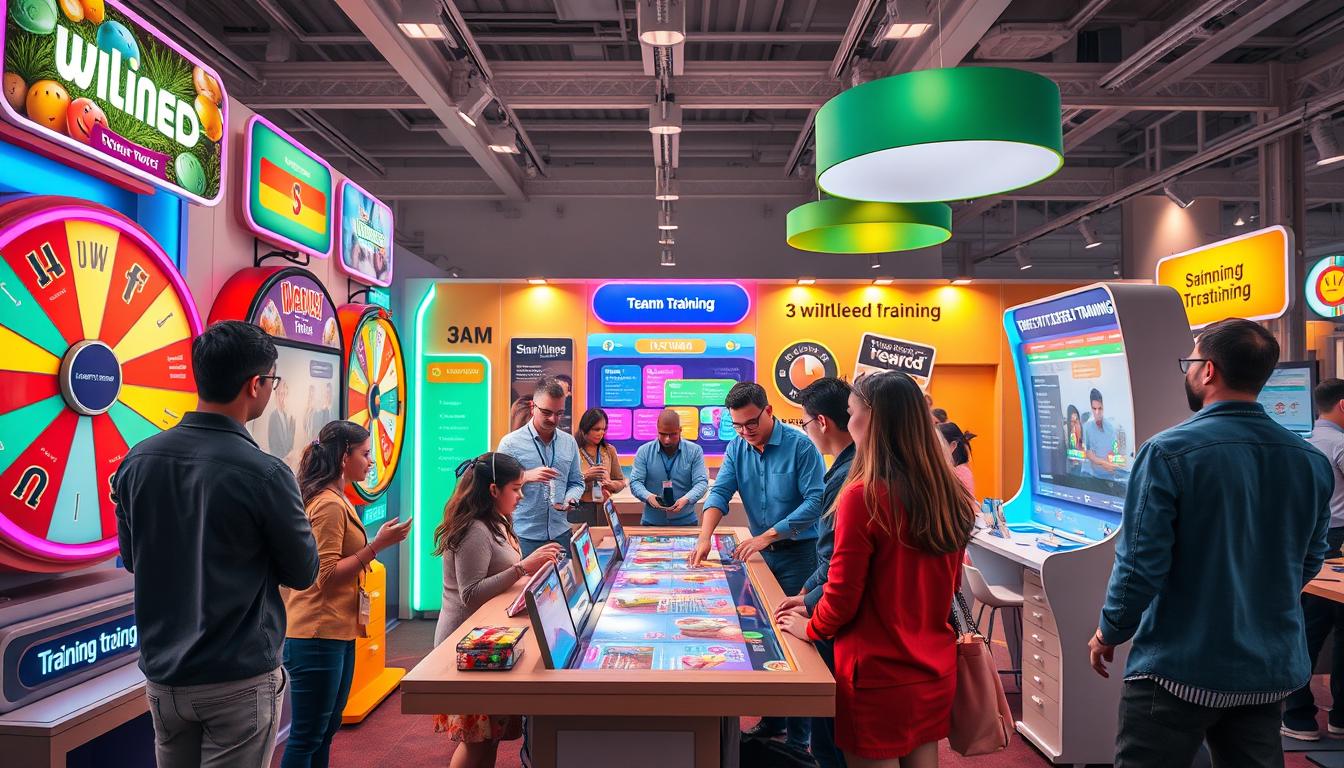Want to make a splash at your next trade show? Learning how to train your team for a successful gamified booth is key. Gamification strategies can transform your booth into a hub of excitement, drawing visitors in and keeping them engaged. By focusing on employee engagement, you’ll create a team that’s ready to tackle any challenge and leave a lasting impression on attendees.
A well-trained team armed with effective gamification strategies can turn your booth into the talk of the event. From interactive displays to digital leaderboards, the possibilities are endless. By investing time in preparing your staff, you’re setting the stage for an unforgettable experience that will have visitors lining up to participate.
Key Takeaways
- Gamification boosts visitor engagement at trade show booths
- Employee training is crucial for gamified booth success
- Interactive elements enhance the overall booth experience
- Digital tools can streamline gamification implementation
- Well-prepared staff are essential for managing booth activities
- Measuring success helps refine future gamification strategies
How to Train Your Team for a Successful Gamified Booth
Training your team for a gamified booth requires a strategic approach. By focusing on interactive booth design and team motivation techniques, you can create an unforgettable experience for visitors.
Understanding the Core Elements of Booth Gamification
Gamification in booth design involves incorporating game-like elements to engage visitors. This can include challenges, rewards, and competitive aspects. The key is to create an environment that encourages participation and enhances the overall booth visitor experience.
Setting Clear Training Objectives
Define specific goals for your team to achieve during the event. These might include:
- Mastering the rules and mechanics of your booth’s games
- Understanding product knowledge to answer visitor questions
- Developing skills in visitor engagement and interaction
Developing a Training Timeline
Create a structured timeline for team preparation. This ensures everyone is ready for the event.
| Timeline | Training Focus |
|---|---|
| 4 Weeks Before | Introduction to booth concept and gamification elements |
| 3 Weeks Before | Product knowledge and visitor engagement techniques |
| 2 Weeks Before | Role-playing and scenario practice |
| 1 Week Before | Final review and team motivation session |
By following this approach, you’ll equip your team with the skills needed for a successful gamified booth experience. Remember, the key to success lies in combining engaging interactive booth design with effective team motivation techniques.
Essential Skills for Gamified Booth Staff
Gamified booth staff need a unique set of skills to create memorable experiences for visitors. These skills blend employee engagement strategies with team motivation techniques to drive success.
Effective communication tops the list of must-have abilities. Staff should explain game rules clearly and engage visitors in friendly conversation. They need to be quick thinkers, adapting their approach based on each visitor’s reactions.
Tech-savvy individuals thrive in gamified environments. Familiarity with digital tools and gadgets is crucial for smooth booth operations. Staff must troubleshoot minor tech issues without disrupting the visitor experience.
Enthusiasm and energy are contagious. Booth personnel should maintain high spirits throughout long event days, keeping visitors excited about participating in games and activities.
“The key to a successful gamified booth lies in the staff’s ability to create a welcoming atmosphere that encourages participation and fosters memorable interactions.”
Problem-solving skills are vital when dealing with unexpected challenges. Staff should think on their feet and find creative solutions to keep the booth running smoothly. This adaptability is essential for maximizing visitor engagement and driving results.
| Skill | Importance | Application in Gamified Booth |
|---|---|---|
| Communication | High | Explaining rules, engaging visitors |
| Tech Proficiency | High | Operating digital tools, troubleshooting |
| Enthusiasm | Medium | Maintaining visitor excitement |
| Problem-solving | Medium | Handling unexpected challenges |
By focusing on these core skills, booth staff can create an engaging environment that drives participation and leaves a lasting impression on visitors.
Creating an Engaging Interactive Booth Environment
An interactive booth design can transform your trade show presence. By crafting an immersive space, you’ll captivate attendees and leave a lasting impression. Let’s explore key strategies to enhance booth visitor experience.
Designing Interactive Touchpoints
Interactive elements are crucial for booth visitor experience enhancement. Consider these engaging touchpoints:
- Touch screens with product demos
- Virtual reality experiences
- Interactive games related to your brand
- Photo booths with branded frames
Implementing Digital Technology Solutions
Leverage technology to create a cutting-edge booth environment. Integrate digital solutions that streamline visitor interactions and data collection. Some options include:
- RFID badges for personalized experiences
- Mobile apps for booth navigation
- Augmented reality product displays
- Digital lead capture systems
Optimizing Visitor Flow and Experience
Design your booth layout to guide visitors through a seamless journey. Create distinct zones for different activities, ensuring smooth traffic flow. Use signage and lighting to direct attention and highlight key areas.
| Booth Area | Purpose | Interactive Element |
|---|---|---|
| Welcome Zone | Greet and orient visitors | Digital check-in kiosk |
| Product Showcase | Highlight key offerings | Touchscreen product catalog |
| Demo Area | Hands-on experiences | VR product simulations |
| Networking Space | Facilitate conversations | Interactive seating with charging stations |
By focusing on these aspects of interactive booth design, you’ll create an environment that not only attracts visitors but also keeps them engaged, leading to meaningful connections and potential business opportunities.
Gamification Strategies That Drive Results
Gamification strategies transform booth experiences, boosting employee engagement and visitor interest. By blending fun with purpose, these tactics create memorable interactions that yield tangible results.
Point Systems and Rewards
Implementing a point system adds a competitive edge to booth activities. Visitors earn points for participating in demos, answering quizzes, or sharing on social media. These points can be redeemed for prizes, creating a compelling reason to engage deeply with your booth.
Competition Elements
Friendly competition fuels excitement. Leaderboards display top performers, sparking a desire to climb the ranks. Timed challenges or team-based contests encourage collaboration and repeat visits to the booth.
Progress Tracking Methods
Visual progress indicators keep participants motivated. Digital badges, completion bars, or physical punch cards provide a sense of achievement and prompt further engagement.
| Strategy | Benefits | Implementation |
|---|---|---|
| Point Systems | Increased interaction, Longer booth visits | Digital kiosks, Mobile apps |
| Competitions | Higher energy, Viral marketing | Live leaderboards, Social media challenges |
| Progress Tracking | Sustained engagement, Data collection | Digital badges, Physical stamp cards |
These gamification strategies not only drive results but also provide valuable data on visitor preferences and behavior, informing future marketing efforts and product development.
Team Motivation and Performance Metrics
Boosting team motivation is key to a successful gamified booth. Effective team motivation techniques can transform your booth staff into enthusiastic brand ambassadors. By setting clear goals and providing incentives, you’ll see a dramatic increase in employee engagement and overall booth performance.
One powerful way to motivate your team is through friendly competition. Create a leaderboard that tracks individual and team contributions. This not only drives performance but also fosters a sense of camaraderie among staff members. Remember, the goal is to inspire, not intimidate.
Recognition plays a crucial role in maintaining high levels of employee engagement. Acknowledge top performers publicly and offer rewards that align with your team’s interests. This could range from exclusive training opportunities to bonus incentives.
To measure success, establish clear performance metrics. These should align with your overall booth objectives and be easily trackable. Consider metrics such as:
- Number of visitor interactions
- Lead quality scores
- Conversion rates
- Customer satisfaction ratings
Regularly review these metrics with your team. This transparency not only helps in identifying areas for improvement but also keeps everyone focused on shared goals.
“The right mix of competition, recognition, and clear metrics can turn your booth staff into a high-performing, motivated team.”
| Motivation Technique | Impact on Performance | Implementation Difficulty |
|---|---|---|
| Leaderboards | High | Low |
| Public Recognition | Very High | Low |
| Performance-based Rewards | High | Medium |
| Regular Feedback Sessions | Medium | Medium |
Technology Integration for Booth Success
Cutting-edge tech is the backbone of successful interactive booth design. By leveraging digital tools and data analysis, exhibitors can create immersive experiences that captivate attendees. Let’s explore how technology enhances gamification strategies and boosts booth performance.
Digital Tools and Software Solutions
Modern booths rely on a variety of digital tools to engage visitors. Interactive touchscreens, virtual reality headsets, and mobile apps are just a few examples. These technologies allow for personalized interactions and seamless data collection, enhancing the overall booth experience.

Data Collection and Analysis
Gathering and analyzing visitor data is crucial for refining gamification strategies. RFID badges, QR codes, and digital surveys help collect valuable insights. This information guides exhibitors in tailoring their approach to match attendee preferences and improve future booth designs.
Real-time Performance Monitoring
Real-time monitoring tools enable exhibitors to track booth performance on the fly. These systems provide instant feedback on visitor engagement, allowing staff to make quick adjustments. By optimizing interactions in real-time, booths can maximize their impact and achieve better results.
“Technology is the secret sauce that makes interactive booth design truly shine. It’s not just about flashy gadgets; it’s about creating meaningful connections with attendees.”
By integrating these technological elements, exhibitors can create dynamic, data-driven booth experiences that stand out on the trade show floor. The key is to balance innovation with user-friendly design, ensuring that technology enhances rather than overwhelms the visitor experience.
Managing Visitor Engagement and Experience
Successful booth management hinges on creating memorable interactions and handling visitor traffic effectively. By focusing on booth visitor experience enhancement, you can leave a lasting impression on attendees and maximize your event ROI.
Creating Memorable Interactions
Interactive booth design plays a crucial role in engaging visitors. Use touchscreens, virtual reality experiences, or hands-on product demonstrations to captivate your audience. Personalize interactions by leveraging data collected from booth visitors to tailor conversations and follow-ups.
Handling Peak Traffic Periods
During busy times, efficient crowd management is key. Implement a queue management system and train staff to guide visitors smoothly through your booth. Consider using digital check-in processes to reduce wait times and enhance the overall experience.
Troubleshooting Common Challenges
Be prepared to address issues that may arise during the event. Create a quick reference guide for staff to handle common problems, such as:
- Technical glitches with interactive displays
- Managing visitor overflow
- Addressing frequently asked questions
- Dealing with dissatisfied visitors
By anticipating and preparing for these challenges, you can ensure a smooth and enjoyable experience for all booth visitors.
| Challenge | Solution |
|---|---|
| Long wait times | Implement digital queuing system |
| Information overload | Use interactive displays for self-paced learning |
| Lack of engagement | Introduce gamification elements |
Measuring Success and ROI

Evaluating the success of your gamified booth is crucial for refining your gamification strategies and maximizing return on investment. To gauge the effectiveness of how you train your team for a successful gamified booth, focus on these key metrics:
- Visitor engagement rates
- Lead generation numbers
- Social media mentions and shares
- Post-event survey responses
- Sales conversions attributed to booth interactions
Track these metrics using digital tools and compare them to your pre-set goals. This data-driven approach helps identify areas for improvement and validates your investment in booth gamification.
Calculate ROI by comparing the total costs of booth setup, staff training, and gamification elements against the value of leads generated and deals closed. Remember, some benefits, like brand awareness, may be harder to quantify but still contribute to long-term success.
“Gamification isn’t just about fun; it’s about creating measurable business results.”
Gather feedback from both visitors and staff to gain insights into the booth’s strengths and weaknesses. Use this information to refine your gamification strategies and improve team training for future events. By consistently measuring and analyzing performance, you’ll ensure your gamified booth continues to deliver impressive results.
Conclusion
Training your team for a successful gamified booth is key to making a lasting impact. By focusing on employee engagement and interactive experiences, you’ll create a booth that stands out. Remember, a well-prepared team is your secret weapon in turning visitors into loyal customers.
Throughout this guide, we’ve explored how to train your team for a successful gamified booth. From setting clear goals to mastering essential skills, your staff will be ready to tackle any challenge. The right mix of technology, creativity, and people skills will make your booth a hit at any event.
As you put these ideas into action, keep track of what works best for your team. Adjust your approach based on real-world results and feedback. With practice and dedication, your gamified booth will become a powerful tool for connecting with your audience and growing your business.






